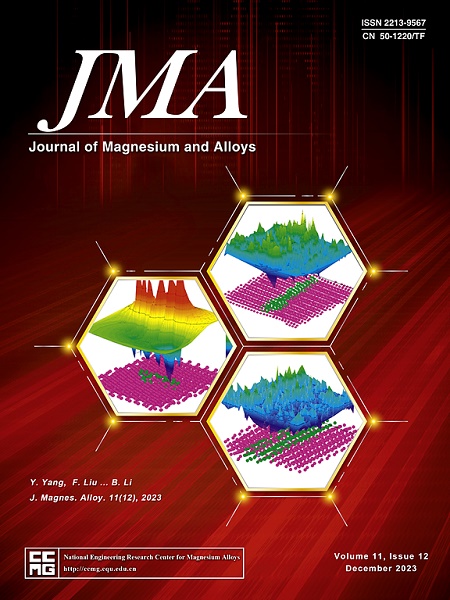The role of different electromagnetic fields in magnesium alloys direct-chill casting: Numerical simulation and experimental investigation
IF 15.8
1区 材料科学
Q1 METALLURGY & METALLURGICAL ENGINEERING
引用次数: 0
Abstract
Based on the magnetic-fluid-thermal multiphysics transient coupling numerical simulation results of the magnesium alloy direct-chill (DC) casting, the effects of conventional vibration electromagnetic field (VMF), differential phase vibration electromagnetic field (DP-VMF), conventional low-frequency electromagnetic field (LFMF), and differential phase low-frequency electromagnetic field (DP-LFMF) on melt flow were systematically investigated from the perspective of impulse. Based on thermal behavior and crystal growth theory, the relationships between the velocity field, temperature field, and the morphology of the solidification structure were discussed, and the effect and mechanism of different electromagnetic fields in improving the solidification structure were revealed. Simultaneously, the effects of different electromagnetic fields on AZ31B and AZ80 alloys were investigated. The DC casting experiment verified the theoretical results. Results show that applying low-frequency electromagnetic fields (LFMF and DP-LFMF) can effectively inhibit the formation of columnar grain, but the effect of microstructure refinement is weak; the impact of vibration electromagnetic fields (VMF and DP-VMF) is precisely the opposite. The structure refinement effect of DP-VMF and the inhibition effect of DP-LFMF on columnar grains are better than those of their conventional electromagnetic fields. In the presence of DP-VMF, the average grain size of the center, 1/2 radius, and the edge of the ingot decrease by about 42%, 49%, and 77%, respectively, compared with no electromagnetic field.
不同电磁场在镁合金直接冷却铸造中的作用:数值模拟与实验研究
基于镁合金直冷(DC)铸造磁-流-热多物理场瞬态耦合数值模拟结果,从冲量角度系统研究了常规振动电磁场(VMF)、差相振动电磁场(DP-VMF)、常规低频电磁场(LFMF)和差相低频电磁场(DP-LFMF)对熔体流动的影响。基于热行为和晶体生长理论,讨论了速度场、温度场和凝固结构形态之间的关系,揭示了不同电磁场对改善凝固结构的作用和机理。同时,研究了不同电磁场对 AZ31B 和 AZ80 合金的影响。直流铸造实验验证了理论结果。结果表明,应用低频电磁场(LFMF 和 DP-LFMF)可有效抑制柱状晶粒的形成,但细化微观结构的效果较弱;振动电磁场(VMF 和 DP-VMF)的影响恰恰相反。DP-VMF 的结构细化效果和 DP-LFMF 对柱状晶粒的抑制效果均优于其常规电磁场。与无电磁场相比,在 DP-VMF 作用下,铸锭中心、半径 1/2 和边缘的平均晶粒大小分别减少了约 42%、49% 和 77%。
本文章由计算机程序翻译,如有差异,请以英文原文为准。
求助全文
约1分钟内获得全文
求助全文
来源期刊

Journal of Magnesium and Alloys
Engineering-Mechanics of Materials
CiteScore
20.20
自引率
14.80%
发文量
52
审稿时长
59 days
期刊介绍:
The Journal of Magnesium and Alloys serves as a global platform for both theoretical and experimental studies in magnesium science and engineering. It welcomes submissions investigating various scientific and engineering factors impacting the metallurgy, processing, microstructure, properties, and applications of magnesium and alloys. The journal covers all aspects of magnesium and alloy research, including raw materials, alloy casting, extrusion and deformation, corrosion and surface treatment, joining and machining, simulation and modeling, microstructure evolution and mechanical properties, new alloy development, magnesium-based composites, bio-materials and energy materials, applications, and recycling.
 求助内容:
求助内容: 应助结果提醒方式:
应助结果提醒方式:


